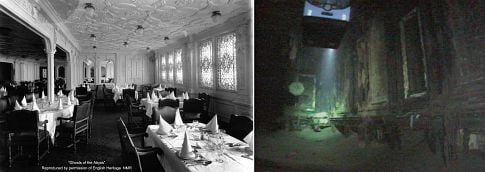Ghosts of the Abyss

Acclaimed filmmaker James Cameron - of course, everyone knows him as the creator of "Titanic" - has taken his fascination with the world's most famous shipwreck and brings us into the very bowels of that ship in "Ghosts of the Abyss."
Robin's Review: A-
I guess when you make a film that is the greatest box office draw ever you can indulge your curiosity in ways we mere mortals can only dream. Cameron has put together an amazing team of technicians, archaeologists and historians to mount his mission to complete the research work he began in 1995 when he first brought his cameras 21/2 miles down into the North Atlantic to photograph the ghostly Titanic. With "Ghosts of the Abyss" he abandons the restrictions of feature film making and directs his energies in his in-depth exploration of the ill-fated ship that struck an iceberg on its maiden voyage in 1912 with the tragic loss of 1500 souls.
The tactical obstacles of the project were staggering, but Cameron and his team, with actor Bill Paxton along to provide narration and an everyman perspective, show how to be masters of an alien universe, even if just for a while. The project involved two ocean-going research ships and two MIRs (deep-sea submersibles) and the creation of two very special remote controlled underwater camera dubbed Jake and Elwood. The ROVs (Remotely Operated Vehicles) were specially designed by the director's brother Michael Cameron and could travel up to two thousand feet from the MIR, controlled over a very fine fiber optic cable. The invention allowed the filmmakers to poke and photograph into any nook or cranny that Jake and Elwood could fit into - with remarkable results.
The astounding effort also incorporates state-of-the-art 3D technology into the mix that makes "Ghosts of the Abyss" the perfect film to be seen at IMAX theaters across the country. The effect is remarkable to see and Cameron and company used it to make you flinch, at first, when one of the MIRs external claws comes out of the screen at you, but this is just to get your attention. After the initial getting used to, the 3D is used to terrific affect to bring the viewer into the center of this strange world.
But, an hour's worth of 3D photography of the wreck of the Titanic would be interesting from a historical or modern archaeological standpoint but would not really have a mainstream draw. We are dealing with James Cameron, however, and the showman's talent comes to the fore. As his roving cameras take you into the heart o the Titanic, displaying such things as the beautiful, still intact stained glass in the ship's luxurious dining room, Cameron adds different perspectives to the split screen images of Jake and Elwood's cameras. Old 3D stereopticon slides from when the Titanic was being built are used effectively as is the CGI recreations that are used to overlay the ghostly images, giving the viewer a look at how things were before the disaster. Finally, Cameron introduces the film's "ghosts" with the shadowy images of live actors laid over the images of the ship - the bridge where the fateful last command was given, the grand staircase, the massive engine room - giving a glimpse of what may have happened over 90 years ago.
This hugely ambitious undertaking was not without problems, though, and Cameron uses the near disaster when Elwood's battery fails and the roving camera is beyond the submersible crew's grasp. The exciting rescue attempt, using Jake to spear and tow his brother, is punctuated with a somber, thoughtful note that changed the teams elation to sobriety when they return to the surface to learn of the events of 11'09'01. Cameron exhibits the humbleness of a great, creative mind that understands all things in perspective and this is what "Ghosts of the Abyss" is about.
The technical undertaking - not just Mike Cameron's inventive genius with Jake ad Elwood - is on a par of its own. This is a highly trained, veteran crew of mariners who represent the cream of the crop in their respective fields. Nothing in the production of "Ghosts of the Abyss" is done by half and it shows on all levels, from the divers assisting the mission to the tight editing (by Ed W. Marsh, Sven Pape and John Rafoua) of the final product.
"Ghosts of the Abyss" will, likely, be available on DVD with extra footage and narration but the film, to be really appreciated should be seen in its IMAX 3D presentation. You won't be disappointed.

